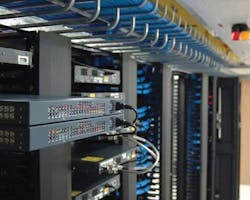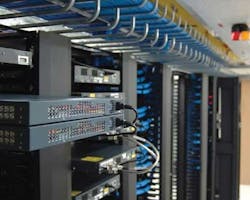Preterminated systems a green solution in data centers and LANs
By Benoit Chevarie, Belden
Today's IT-centric world has set in motion trends that influence how enterprises of every size regard their technology and communications networks and networking infrastructure. While the established imperatives of "faster, better, more-cost-effective" still hold sway in the cabling and connectivity component market, some other important decision factors also have come into play.
In designing and implementing their high-density networks, many data centers and data-reliant businesses are seeking to make more sustainable, environmentally sound choices. They want systems that provide high performance and reliability for maximum network uptime over the long term—but they don't want to incur the high costs down the road for upgrades, system maintenance and management. With an ever-increasing need for higher bandwidth and flexibility to accommodate future growth, they are now looking at the network's physical media infrastructure and its overall life cycle as a capital investment essential to achieving corporate goals.
One trend is the growing adoption of preterminated structured cabling systems. Preterminated optical-fiber and copper cabling systems are bundled and preterminated at the factory, eliminating the necessity for on-site field termination. They are most suited for network installations that are planned well in advance, taking into account both current and future requirements.
In this article we'll take a look at how preterminated cabling systems provide a greener approach to building mission-critical technology networks—where they are economically feasible as a long-term investment.
Flexibility and sustainability
Data centers and enterprises seem to be changing their mindset about the role of the network by taking a longer life-cycle view of the network's physical layer. It all starts with network infrastructure design and deployment.
In traditional cabling installation projects, once a networking topology is formulated and approved, installers typically haul in large volumes of cabling to be installed and terminated at the user's site. Depending on the size and scope of the installation, the implementation process may take days, weeks or even months. In the case of new construction, installers may be forced to work around plans and schedules of various subcontractors (e.g. electrical, HVAC and others), which can often cause delays. In retrofits, they may need to plan their work so as not to disrupt ongoing operations and network performance. This too can impose work-schedule constraints. At the end of the deployment process, installers are usually left to deal with unused cabling, discarded packaging and other scrap and waste.
With a preterminated system, the planning process typically requires more time upfront and more detailed analysis to determine specific cabling and termination routes along the cable trays and within the cabinets. This detailed analysis is used to establish the required length of cable runs in various areas, including an appropriate allowance for cable slack. Once the detailed plan is formulated and approved, the system's cabling and connectivity components are manufactured and tested at the factory to ensure they meet all applicable industry standards prior to delivery.
Once delivered, preterm systems are like building blocks. Following the detailed plan at the user's site, installers can assemble and terminate the entire system relatively quickly, without the need for special tools or field termination. That's why manufacturers often call their preterminated systems "plug-and-play" solutions. When the installation job is complete, there are no excess materials left over and minimal scrap to be hauled away.
Taken in their totality, the life cycle benefits of preterminated systems can be significant. At the front end, benefits relate to installation time, labor cost and material reduction with less waste, space and energy savings, and network performance and quality. Because of the modularity of data center design, preterminated cables can be reused in different areas of a data center to accommodate network rearrangements. Further downstream, life-cycle factors include ongoing maintenance and cable management, dealing with upgrades, and the ability to make changes on the fly based on network growth, business decisions and changing needs.
Experience has shown that data centers, data-intensive businesses, and other specialized agencies and organizations stand to gain the most from implementation of a preterminated structured cabling system to support their mission-critical networks. A few examples of where a preterminated system might be particularly appropriate include the following.
- Data centers and storage area networks where high density is required in limited space
- Traditional enterprise local area networks (LANs) requiring high bandwidth, rapid installation and minimal downtime
- Specialized data and voice networking environments such as trading floors, convention halls and call centers—or any environment in which disruption to the network or ongoing business operations is not an option
- New office construction demanding rapid installation time, or existing sites where upgrades need to be done quickly, with minimal downtime
- Disaster-recovery situations, where communications need to be deployed as quickly as possible in a temporary setting and disassembled when the situation is resolved
Lowering TCO
One of the factors business enterprises and data centers look at in considering capital investment is total cost of ownership (TCO) over the life cycle of the program or project. When it comes to the life cycle of the IT networking infrastructure, TCO takes into account the initial investment, installation time and costs, ongoing maintenance and management expense, and the expected service life of the system and/or components.
Among the end-to-end life-cycle benefits of preterminated cabling systems are the following.
In evaluating, selecting and specifying optical-fiber or copper preterminated cabling and connectivity systems, be sure that the products fully comply with all industry standards for structured cabling and/or data center cabling installations, and that they are compatible with conventional field-terminated components. The use of preterminated components should not compromise the end-to-end channel performance. This is particularly important for installations containing more than two connectors and for short cable runs. All the components need to be qualified for the Category of performance that is specified.
This cabling installation in Tornto, Canada shows the Belden preterminated cables routed in an underfloor cable tray. Belden's system is one that uses a braided sleeve and pulling eyes for additional protection in environments like this one.
Because the computing environments and business needs of organizations differ widely, not every enterprise will find the benefits of preterminated systems outweigh the investment. Preterminated cabling solutions are ideally suited for data center environments where the cable routes are well defined and where the time for deployment, ease of installation, network reliability and manageability are paramount. Field-terminated copper and fiber cabling and connectivity systems are generally less costly to purchase in terms of the various components. However, they carry much higher installation costs because of the time and labor involved. That's why it is important and is in a user's best interests to conduct a cost/benefit analysis before deciding to implement a preterminated cabling system. When you conduct such an analysis, be sure to factor in the greener advantages and life-cycle sustainability as well.
Benoit Chevarie is product line manager for Belden (www.belden.com). He is a mechanical engineer and has more than 20 years' experience in the telecommunications industry.


